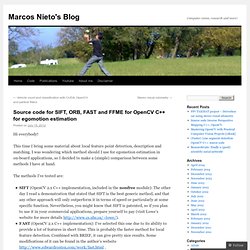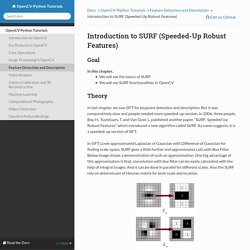

ARma library: Pattern tracking for Augmented Reality. This webpage provides a simple C++ library that relies on OpenCV and can be used in real-time Augmented Reality projects.
In short, it offers the ability to track binary markers and extracts the exterior orientation between tracked pattern and camera. Unlike other known toolkits, it works frame-wise (history is not used), so tracking counts on per-frame detection. Note that the code is provided "as is" without any kind of warranty. The use and the redistribution of the code is only permitted for academic/research purposes. Contact the author if you want to use it for commercial purposes. Augmented Reality systems try to augment a live video feed by addign 3d objects or annotations in the scene appropriately. Binary (black-white) patterns printed in planes are easier to be tracked and have been used as markers in Augmented Reality apps.
Source code for SIFT, ORB, FAST and FFME for OpenCV C++ for egomotion estimation. Hi everybody!

This time I bring some material about local feature point detection, description and matching. I was wondering which method should I use for egomotion estimation in on-board applications, so I decided to make a (simple) comparison between some methods I have at hand. The methods I’ve tested are: SIFT (OpenCV 2.x C++ implementation, included in the nonfree module): The other day I read a demonstration that stated that SIFT is the best generic method, and that any other approach will only outperform it in terms of speed or particularly at some specific function. Nevertheless, you might know that SIFT is patented, so if you plan to use it in your commercial applications, prepare yourself to pay (visit Lowe’s website for more details (OpenCV 2.x C++ implementation): I’ve selected this one due to its ability to provide a lot of features in short time.
Personally, I prefer not so many features, but very distinctive ones, but, at the same time I like algorithms to run fast. IJIP-51. Introduction to SURF (Speeded-Up Robust Features) — OpenCV-Python Tutorials 1 documentation. Theory¶ In last chapter, we saw SIFT for keypoint detection and description.

But it was comparatively slow and people needed more speeded-up version. In 2006, three people, Bay, H., Tuytelaars, T. and Van Gool, L, published another paper, “SURF: Speeded Up Robust Features” which introduced a new algorithm called SURF. As name suggests, it is a speeded-up version of SIFT. In SIFT, Lowe approximated Laplacian of Gaussian with Difference of Gaussian for finding scale-space. For orientation assignment, SURF uses wavelet responses in horizontal and vertical direction for a neighbourhood of size 6s. .
For feature description, SURF uses Wavelet responses in horizontal and vertical direction (again, use of integral images makes things easier). . For more distinctiveness, SURF feature descriptor has an extended 128 dimension version. And are computed separately for . Are split up according to the sign of , thereby doubling the number of features. Features2D + Homography to find a known object. Opencv-processing/examples/MarkerDetection/MarkerDetection.pde at master · atduskgreg/opencv-processing. How to Make an Augmented Reality Game with Open CV. Defend the world against virtual invaders in this tutorial This is the third part of a four-part series on implementing Augmented Reality in your games and apps.

Check out the first part and the second part of the series here! Welcome to the third part of this tutorial series! In the first part of this tutorial, you used the AVFoundation classes to create a live video feed for your game to show the video from the rear-facing camera. In the second part, you learned how to implement the game controls and leverage Core Animation to create some great-looking explosion effects. Your next task is to implement the target-tracking that brings the Augmented Reality into your app. If you saved your project from the last part of this tutorial, then you can pick up right where you left off.
Augmented Reality and Targets Before you start coding, it’s worth discussing targets for a moment. Markers are real-world objects placed in the field-of-view of the camera system. Designing the Pattern Detector.